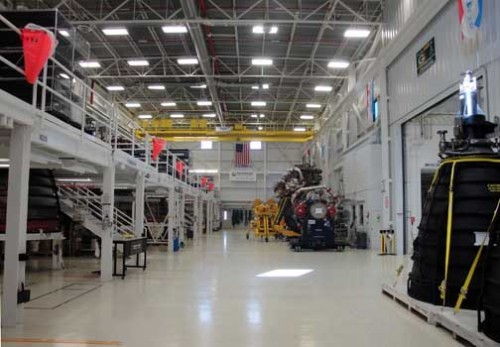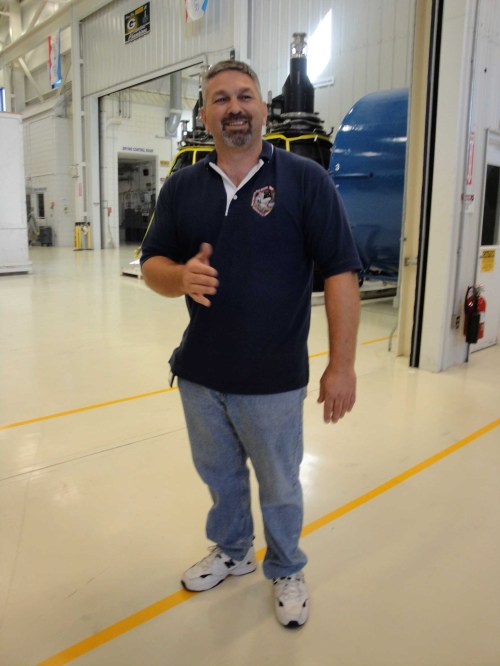
(CLICK to ENLARGE) The SSMEPF is on two levels. This is a map of the main level. The facility was built by Boeing in 1998 and adjoins OPF-3. In 2011, with the shuttle program ended, Boeing took over OPF-3 and is expected also to take over the SSMEPF when the last of the shuttles are shipped to Mississippi for storage.
The three main engines at the rear of the Shuttle were removed almost immediately after arrival at the OPF by the Space Shuttle Main Engine Processing Facility (SSMEPF) personnel. The engines were taken to the SSMEPF adjoining OPF-3 and placed together in a glorified oven for eight hours, at a temperature of 160 degrees, to completely dry the engines.
Then the engines were serviced, placed in storage in the climate controlled SSMEPF to await another flight.
How many Main Engines did and does NASA have? At the beginning of the program in 1981, NASA has four shuttles and fifteen engines. Three for each shuttle (12) and an additional three spare engines. During the program six engines were lost — three in the Challenger accident, and three in the Columbia accident. The Challenger was replaced, as were its engines. At the end of the program, counting replacements, NASA had fourteen engines remaining.
Are the engines on Discovery at the Smithsonian the real engines? No. There was discussion about the Smithsonian wanting the Main Engines to be left on the Shuttle Discovery, the oldest survivor in the fleet.
It didn’t happen.
The engines on the Discovery, placed on the shuttle on December 5, 6 and 7, 2011 in OPF-1, are primarily pieces of other engines, including parts that were test parts. The engines on the Discovery when she arrives at the Air and Space Mueaum at Dulles Airport in Washington, DC, are not engines that ever flew in space.

(CLICK to ENLARGE) The SSMEPF is located across the street from the Vehicle Assembly Building in the area that includes all three shuttle hangars which were known as Orbiter Processing Facilities or OPFs.
They are remarkably complex pieces of technology composed of 50,000 parts. Each engine is 14 feet (4.2 meters) long and 7.5 feet (2.25 meters) in diameter at the end of its nozzle.
Each engines weighs 7,000 pounds.
And the engines generated different amount of power. The meant that, because the engines were interchangeable, a shuttle could be outfilled with either more powerful, or less powerful, engines depending on the mission.
The Processing Facility building. Until 1998 the Main Engines were serviced and maintained in the Vehicle Assembly Building (VAB). Then a 34,600 square foot building was built to house the engine facility adjoining OPF-3. The building was designed and built by Boeing-Rocketdyne’s Space Shuttle Main Engine Team.
What happens to the Engines now? All engines will be shipped, at the rate of one a month, to the NASA John C. Stennis Facility in Mississippi for storage. There they will await the next space missions which are expected to be similar to the Apollo program where all engines were lost during re-entry and discarded in the ocean. In other words, while these engines each have flown in space many times, they likely will fly in space only once more and will be discarded.
In the facility six engines could be worked on at a time on two levels.
The full two-page fact sheets of the SSMEPF is at the bottom of this post.
To read, click on the image to enlarge it.
.

Six engines can be worked on at a time, and three can be wired up and monitored on three separate control boards located on the second floor just behind these bays.
.
.

The six work bays are on the left. Several engines are on the right. This is another view of the bay work area.
.

Each shuttle Main Engine had a number, like this one -- #2044. They were closely monitored for performance, and each -- although technically identical -- performed slightly differently in terms of power delivered. This is as common in automobiles as it is in any type of equipment, including shuttle engines.
.

When shuttles landed, they were taken to one of three hangars (known as OPFs = Orbiter Processing Facility) and their engines were immediately removed and taken here -- to the Drying Room in the SSMEPF. Here for 8 hours, side by side, the three engines that had just returned from space were dried in a sealed room at 160-degrees. Water and condensation were huge enemies of the engines and, need we mention? -- the ocean and salt water is only a couple of miles from the SSMEPF. Once dried, the engines remained in the temperature and humidty controlled SSMEPF until it was time to place them on another shuttle for another mission.
.

The shuttle engines will be placed in this type of container for shipment to Mississippi. Once 150 people worked in the Space Shuttle Main Engine Facility. Today only 40-45 mechanics remain, and when the last engine is shipped, they will be gone as well. It is expected that Boeing, who has already taken over the OPF-3 next door, will take this space. In 1998 Boeing designed and built the SSMEPF.
.

A Main Engine, looiking upward. The top would be inside the shuttle. The engines were stood on end to be serviced. This engine is stored on end.
.

The upper part of the engine on the second floor where most of the engine work was done. The engines were rolled into the bay, then floor (behind the engine in this picture) was secured into place allowing mechanics to work and walk around the entire engine. The engines were manufactured in Canoga Park, California. Six were lost in flight on Challenger and Columbia. Fourteen remain.
.

Three engines could be tested at a time, and a total of six could be worked on in the six bays. There are three Main Engine Pressure Supply Panels (one of which is shown on the right) which were connected to the engines (on left rear) when an engine was being tested.
.

Maintaining and servicing the engines took an enormous amount of specialized tools. These tools will be packed and sent along with the engines for storage and later use.
.

Lead Bob Petrie who worked at KSC for 25 years gave the media a detailed tour of his facility. Once the SSMEPF operated 24 hours a day, but as the program wound down the days slipped only to eight hours, and while the facility remained climate controlled, it was empty and dark most of the time once the end of the program approached.
.

One of two SSME Leads is Bob Petrie. Mr. Petrie has worked on the Main Engines for 25 years and been a lead (head guy) for 12. His official title is Technical Operations Lead, Pratt and Whitney/Rocketdyne. Mr. Petrie guided us through the SSME allowing us access to everything including his office.
.

.

. . . . . . . . . . . . . . .
 .
.
.
.”petecrow/NASA” © 2011 by / Peter M. Crow and the Peter Michael Crow Trust and by Seine/Harbour® Productions, LLC, Studio City, California.
